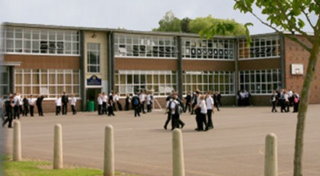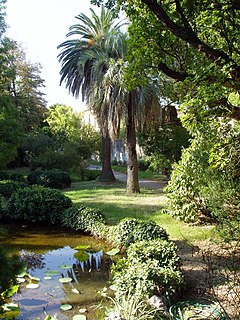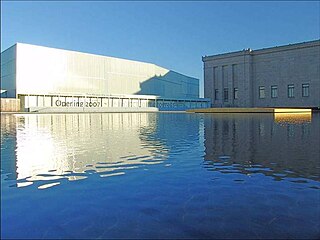
The Nelson-Atkins Museum of Art is an art museum in Kansas City, Missouri, known for its neoclassical architecture and extensive collection of Asian art.

The Speed Art Museum, originally known as the J.B. Speed Memorial Museum, now colloquially referred to as the Speed by locals, is the oldest, largest, and foremost museum of art in Kentucky. It is located in Louisville, Kentucky on Third Street next to the University of Louisville Belknap campus and receives around 180,000 visits annually.

The Musée d'Art Moderne et Contemporain de Strasbourg is an art museum in Strasbourg, France, which was founded in 1973 and opened in its own building in November 1998.
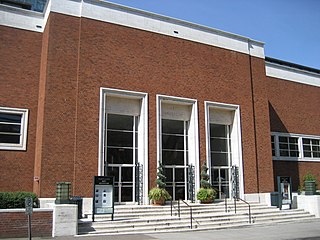
The Portland Art Museum in Portland, Oregon, United States, was founded in 1892, making it the oldest art museum on the West Coast and seventh oldest in the US. Upon completion of the most recent renovations, the Portland Art Museum became one of the 25 largest art museums in the US, at a total of 240,000 square feet, with more than 112,000 square feet of gallery space. The permanent collection has more than 42,000 works of art, and at least one major traveling exhibition is usually on show. The Portland Art Museum features a center for Native American art, a center for Northwest art, a center for modern and contemporary art, permanent exhibitions of Asian art, and an outdoor public sculpture garden. The Northwest Film Center is also a component of Portland Art Museum.
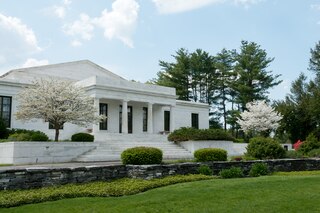
The Sterling and Francine Clark Art Institute, commonly referred to as the Clark, is an art museum and research institution located in Williamstown, Massachusetts, United States. Its collection consists of European and American paintings, sculpture, prints, drawings, photographs, and decorative arts from the fourteenth to the early twentieth century. The Clark, along with the Massachusetts Museum of Contemporary Art (MassMoCA) and the Williams College Museum of Art (WCMA), forms a trio of art museums in the Berkshires. The institute also serves as a center for research and higher learning. It is home to various research and academic programs, which include the Fellowship Program and the Williams College Graduate Program in the History of Art. It is visited by 200,000 people a year.

Musée Marmottan Monet is located at 2, rue Louis Boilly in the 16th arrondissement of Paris and features over three hundred Impressionist and Post-Impressionist paintings by Claude Monet. It is the largest collection of his works.

The Phoenix Art Museum is the Southwest United States' largest art museum for visual art. Located in Phoenix, Arizona, the museum is 285,000-square-foot (26,500 m2). It displays international exhibitions alongside its comprehensive collection of more than 18,000 works of American, Asian, European, Latin American, Western American, modern and contemporary art, and fashion design. A community center since 1959, it hosts year-round programs of festivals, live performances, independent art films and educational programs. It also features The Hub: The James K. Ballinger Interactive Gallery, an interactive space for children; photography exhibitions through the museum’s partnership with the Center for Creative Photography; the landscaped Sculpture Garden; dining at Palette, and shopping at The Museum Store.

The Virginia Museum of Fine Arts, or VMFA, is an art museum in Richmond, Virginia, in the United States, which opened in 1936.

The Portland Museum of Art, or PMA, is the largest and oldest public art institution in the U.S. state of Maine. Founded as the Portland Society of Art in 1882. It is located in the downtown area known area The Arts District in Portland, Maine.
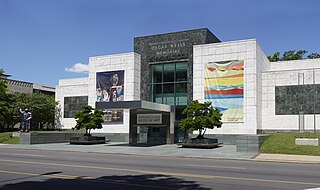
Founded in 1951, the Birmingham Museum of Art in Birmingham, Alabama, today has one of the finest collections in the Southeastern United States, with more than 24,000 paintings, sculptures, prints, drawings, and decorative arts representing a numerous diverse cultures, including Asian, European, American, African, Pre-Columbian, and Native American. Among other highlights, the Museum’s collection of Asian art is considered the finest and most comprehensive in the Southeast, and its Vietnamese ceramics one of the finest in the U.S. The Museum also is home to a remarkable Kress Collection of Renaissance and Baroque paintings, sculpture, and decorative arts from the late 13th century to c.1750, and the 18th-century European decorative arts include superior examples of English ceramics and French furniture.

The Crocker Art Museum, formerly the E. B. Crocker Art Gallery is the longest continuously-operating art museum in the West. Located in Sacramento, California, the Museum hosts one of the state's premier collections of Californian art. The collection contains works dating from the Gold Rush to the present day, a collection of master drawings, European paintings, one of the largest international ceramics collections in the U.S. and collections of Asian, African, and Oceanic art.

The State Art and Sculpture Museum is a museum dedicated to fine arts and sculpture in Ankara, Turkey. It was designed in 1927 by architect Arif Hikmet Koyunoğlu and built between 1927 and 1930 as the Türkocağı Building, upon the direction of Mustafa Kemal Atatürk, the founder and first President of Turkey. It is located close to the Ethnography Museum and houses a rich collection of Turkish art from the late 19th century to the present day. There are also galleries for guest exhibitions.

The Museum of Fine Arts, Houston (MFAH), located in the Houston Museum District, Houston, is one of the largest museums in the United States. The permanent collection of the museum spans more than 6,000 years of history with approximately 64,000 works from six continents.

The Utah Museum of Fine Arts (UMFA) is the region's primary resource for culture and visual arts. It is located in the Marcia and John Price Museum Building in Salt Lake City, Utah on the University of Utah campus near Rice-Eccles Stadium. Works of art are displayed on a rotating basis. It is a university and state art museum.
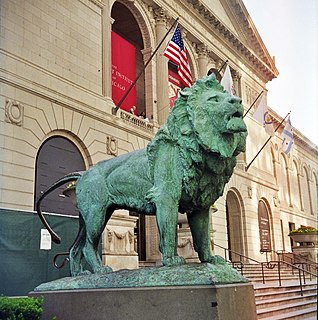
The Art Institute of Chicago, founded in 1879 and located in Chicago's Grant Park, is one of the oldest and largest art museums in the United States. Recognized for its curatorial efforts and popularity among visitors, the museum hosts approximately 1.5 million guests annually. Its collection, stewarded by 11 curatorial departments, is encyclopedic, and includes iconic works such as Georges Seurat's A Sunday on La Grande Jatte, Pablo Picasso's The Old Guitarist, Edward Hopper's Nighthawks, and Grant Wood's American Gothic. Its permanent collection of nearly 300,000 works of art is augmented by more than 30 special exhibitions mounted yearly that illuminate aspects of the collection and present cutting-edge curatorial and scientific research.

York Art Gallery in York, England is a public art gallery with a collection of paintings from 14th-century to contemporary, prints, watercolours, drawings, and ceramics. It closed for major redevelopment in 2013, reopening in summer of 2015. It is managed by York Museums Trust.

The David Collection is a museum of fine and applied art in Copenhagen, Denmark, built around the private collections of lawyer, businessman and art collector C. L. David.

The Iris & B. Gerald Cantor Center for Visual Arts at Stanford University, formerly the Stanford University Museum of Art, and commonly known as the Cantor Arts Center, named after Iris and B. Gerald Cantor, is a complimentary art museum on the campus of Stanford University in Stanford, California. The museum, which opened in 1894, consists of over 130,000 square feet of space, including sculpture gardens. The Cantor Center houses one of the largest collections of Auguste Rodin sculptures outside Paris, France with 199 works by Rodin, most in bronze but also other media; many sculptures are on display in the B. Gerald Cantor Rodin Sculpture Garden.

The Musée des beaux-arts d'Angers is a museum of art located in a mansion, the "logis Barrault", place Saint-Éloi near the historic city of Angers.

The Museum of Cluj-Napoca or National Art Museum, Cluj-Napoca, is an art museum housed in an important eighteenth-century Baroque building, the Cluj-Napoca Bánffy Palace, designed by German architect Johann Eberhard Blaumann. The museum possesses a very valuable collection of Romanian and European art: paintings, graphics and decorative art ranging from the Fifteenth Century to the Twentieth.






